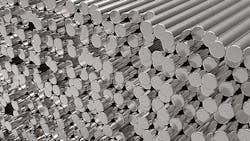A: To answer the second question first: The main difference between 316 and 316L is the carbon level. The latter has a carbon max of 0.03%, and it has a slightly higher Si content. The grain size in 316 stainless often is a function of the forging temperature or other working temperatures (e.g. for extrusion, rolling etc.). Based on my experience with 316, the usual grain size specified for forged products is in the range of 6 to 4 max ASTM. Grains of 3 to 2, or larger, are considered undesirable. I do not think that a grain of 5 or finer is a difficult target if the forging temperatures and annealing cycles are controlled properly.
The main problem with these stainless alloys develops when the final forging reductions are slight, as in reheating and re-striking or cold coined. When such forgings then are annealed, there may be abnormal grain growth in some areas. It is the small reductions of less than 10-15% that lead to this problem. An experienced forger will avoid light reductions in designing the progressions.
It was my experience with the 316 grade that grain sizes between ASTM 4 and 5 could be expected. But, be sure that this is specified at the outset because the grain size is so dependant on the forging practices and the progressions used to finish forge them.
Finally, the lower carbon content carries some added risk of the “critical strain effects” that I discussed in that 2006 column. That is, if the product is finish-forged with light reductions or if they are cold-coined with small reductions, they develop what I call “blown grains,” or scattered large grains that result from the critical strain effects.
For more than 40 years H. James Henning held key technical positions in the forging industry, including as director of technology for the Forging Industry Association, and as president of Henning Education Services, a Columbus, OH, firm specializing in customized education and training in forging technologies.
Guidelines and recommendations offered in this column are based on information believed to be reliable and are supplied in good faith but without guarantee. Operational conditions that exist in individual plants and facilities vary widely. Users of this information should adapt it, and always exercise independent discretion in establishing plant or facility operating practice.
About the Author
H. James Henning
In all, Jim spent 44 years as a technician, engineer, and supervisor in the forging industry prior to his retirement, including nine years as technical director of the Forging Industry Assn.
Upon his retirement from FIA in 1996, Jim formed Henning Educational Services Inc. There, he filled a problem-solving role for forgers and other manufacturers seeking solutions to process and organizational issues. He shared his expertise on hot, cold, and warm forging, on tool design principles, process and equipment selection, and productivity and quality improvements.
